Frescos by Benozzo Gozzoli

|
The single-aisled hall church with three apsidal chapels
and an open roof truss, built by the Augustinian canons between 1280 and
1298, is a typical example of the Gothic architecture of the mendicant
orders in central Italy. |
Benozzo Gozzoli received the commission from Fra Domenico Strambi, a
learned Augustinian monk belonging to the monastery.
The cycle depicts 17 scenes from the life of St. Augustine. When selecting
scenes from the legend of St Augustine, Benozzo had to create his own iconography
without using models, and Domenico Strambi helped him to achieve this.
His cycle of the Doctor of the Church is one of the main works of Tuscan
narrative art.
The 17 pictures, which are arranged in three rows, use the traditional
horizontal direction of reading, from the bottom left to the top right.
In the lowest register Benozzo depicts the education, teachings and journeys
of the saint. The middle register shows St.Augustine's path to Christian
faith, and the lunette fields shows the culmination of his jorney through
life.
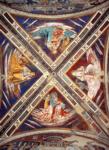
|
The Four Evangelists on the vault symbolize the
kingdom of God. |
The First Row of Frescos
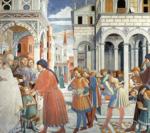
|
The School of Tagaste is the first fresco in the
narration. On the left, the young Augustine's first day at the elementary
school in Tagaste is depicted, and on the right, his quickness and eagerness
to learn. Within the family group his mother, St. Monica, is highlighted
by means of a golden halo. |
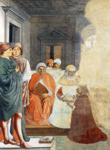
|
The next fresco is St. Augustine at the University
of Carthage, where he studied rhetoric and philosophy. The fresco has
been severely damaged. |

|
St. Augustine Leaving His Mother. St. Monica appears
twice on this fresco - on the left she is praying in a church. On the right
she is blessing her departing son. |

|
Disembarkation at Ostia. St. Augustine is coming
to Italy, at the harbor of Ostia near Rome, in search of true knowledge. |
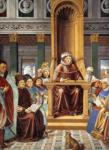
|
St Augustine Teaching in Rome. St. Augustine on
this fresco, older than on previous ones, is depicted as a scholar of rhetoric. |
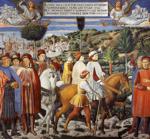
|
St. Augustine Departing for Milan. St. Augustine
left Rome in the autumn of 384 in order to take up the position of municipal
teacher of rhetoric in Milan. It's believed that the man in the scarlet
garment in the right corner of the picture is the self-portrait of Benozzo. |
The Second Row of Frescos
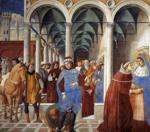
|
Arrival of St. Augustine in Milan. Three
scenes from the legend of St. Augustine are combined in one fresco and
are shown as simulteneous events. In the center, a servant is helping the
just arrived St.Augustine to take off his riding clothes. In the background
St. Augustine is kneeling before a Muslim scholar. On the right, St. Augustine
is greeted by St. Ambrose. |
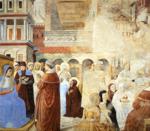
|
Scenes with St. Ambrose. On the left St.
Augustine is standing and listening to St. Ambrose. On the right, St. Augustine
is meditating on St. Ambrose's preaching. |

|
St. Augustine Reading the Epistle of St. Paul.
St. Augustine is depicted in a garden, where, accoding to tradition, he
heard the voice of a child repeatedly telling him to read the Gospels. |

|
Baptism of St. Augustine. St. Augustine
was baptized by St. Ambrose. In the scene he is depicted surrounded by
his followers, including his mother, St. Monica, who is standing behind
him. The clergyman who is holding the newly baptized man's clothing is
thought to be a portrait of Domenico Strambi, the man who commissioned
the cycle. |
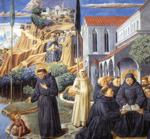
|
The Parable of the Holy Trinity and the Visit to
the Monks of Mount Pisano.
On the left, Christ appears in the form of a boy who is attempting
to transfer all the waters of the ocean into a small hollow using a spoon.
When St. Augustine, who was meditating on the mystery of the Holy Trinity,
explained to the boy how pointless his actions were, the latter replied
that thinking about the mystery of the Holy Trinity was even more fruitless.
In the background, St. Augustine is talking to a group of monks and
a path leads to a monastery on a top of the mountain; the scene depicts
a legend according to which St. Augustine visited the hermit monks on the
Mount Pisano and founded the monastery there.
On the right, St. Augustine is reading to the monks the rules of their
new monastery. The legend suggested that the Augustinian hermits had originated
in Tuscany.
In fact, St. Augustine founded his community in the fourth century
in nothern Africa. The rule of the Augustinians, dating from 338-389, is
the oldest Western monastic rule. In 12 short chapters it lays down the
fundamentals of monastic life. The goals of the monastic community are
poverty, brotherly love, obedience, prayer, reading the Scriptures, work
and apostolic work; a life characterized by seclusion and humility. In
1256, Pope Alexander (1254-1261) founded the order of Augustinian hermits
by combining several groups of Italian hermits who had been living according
to the rule of St. Augustine since 1243. |
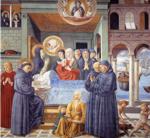
|
Death of St. Monica, is the last fresco
in the second row. St Monica is praying on her deathbed. Domenico Strambi
is standing on the right of the bed wearing the blue cap. On the right,
through the colonnade, one can see the departure of St. Augustine to Numibia. |
The Third Row of Frescos, Lunettes
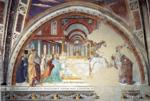
|
Blessing of the Faithful at Hippo. The
right part of the fresco is badly damaged, St. Augustine can be recognized
by his bishop's miter, he's blessing the kneeling people on the left part
of the fresco. |

|
Conversion of the Heretic. The event is
described in the Golden Legend, the Manichaeist presbyter Fortunatus is
being converted by St. Augustine. The Legend says about many conversion
made by St. Augustine. On the fresco, St. Augustine is wearing the Augustinian
monk habit, and his bishop's surplice over it. |

|
St. Augustine's Vision of St. Jerome. St.
Augustine is depicted as a scholar working on a treatise, he entered into
a mystical communication with St. Jerome. |
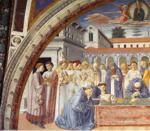
|
Funeral of St. Augustine concludes the
cycle of frescos. |
The two entrance pillars to the chapel round off the fresco paintings
with four saints in niches on each side.

|
St. Monica.
St. Monica, the mother of St.
Augustine. In contrast to customary iconography, she is holding a book
instead of a rosary. This may be a reference to her son's eagerness to
study, for he learnt about the Christian faith from his mother. |

|
St. Gimignano.The patron saint of San Gimignano
is holding a realistic view of the town in his hands. According to legend
he, the bishop of Modena, protected the small town of Sylvio from the attacks
of Attila. The town changed its name into San Gimignano. |

|
St. Sebastian. More. |

|
St. Bartolus. St. Bartolus (1228-1300), the patron
saint of protection from infectious diseases. He was born in San Gimignano
in 1228 and lived as a member of the Third Order of Franciscans in the
monastery of San Vito in Pisa. He ran the leper home in Celole near San
Gimignano for 20 years. |

|
St. Nicholas of Bari. More. |

|
St. Fina. More. |

|
St. Nicholas of Tolentino. St. Nicholas
of Tolentino, who was canonised only in 1446, was one of the most popular
saints of the order of Augustinian hermits, which he entered in 1255. His
attribute is a white lily, a symbol of the purity of his mind. |

|
Raphael and Tobias. More. |
























